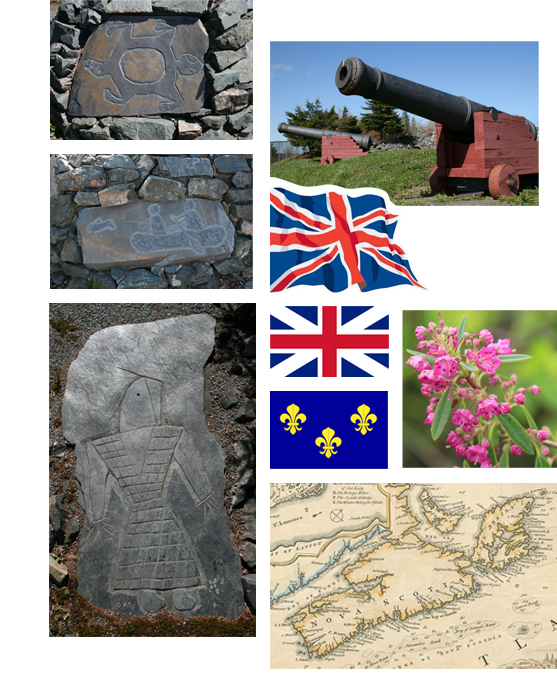Nova Scotia’s Natural History
Our grounds at Mastodon Ridge celebrate several points of interest of Nova Scotia’s natural history. Marvin, our mastodon replica, stands high on the ridge above the park. Explore our website for more information on the mastodon in Nova Scotia and the time period when it lived.
Take a walk through the park and marvel at the petroglyphs hand carved by a local Mi’kmaq artist, integrated into the natural surroundings of indigenous trees and plants. Nova Scotia was a wild and foreboding place to the European settlers who arrived from France and Britain throughout the 17th and 18th centuries. On display are two canons that protected settlers in days gone by. Expand the topics below for a few more highlights on our natural history!
Mastodon
Mastodon Ridge features a life-size reproduction of the mastodons who roamed this region 79,000 years ago. While mastodons and mammoths no longer exist, they are wooly cousins of present-day elephants. During its lifetime, the mastodon would have been living in a climate somewhat colder than our own, feeding on conifers and marsh vegetation.
Mastodons are found in the fossil record from 10,000,000 years ago to when they went extinct 10,000 years ago. No one knows exactly why they went extinct, perhaps hunting caused their demise.
The reconstructed skeleton of our mastodon, discovered in 1991 in a gypsum quarry in Milford, is on display at the Nova Scotia Museum of Natural History in Halifax, NS.
Several fossils of these mastodon bones, including a tooth, rib bone, hip section, shoulder blade and section of the tusk, are on display at Mastodon Ridge.
The Ice Age
The Earth’s natural history is a series of events that have at times, completely exterminated one global environment and replaced it with another.
This part of the world was shaped by a major series of ice ages known as The Pleistocene Glaciation, a glacial episode that began about 37 million years ago. During this time global temperatures drop significantly. Plant, trees and animals crowd into warmer regions.
Finding mastodon fossils and all the associated material from 80,000 years ago tells us that the climate was cooling between glaciations in North America. This inter-glacial time, called the Sangmonian, lasted from 125,000 years ago to 75,000 years ago.
History of Nova Scotia Forest
After the ice retreated, major factors affected Nova Scotia forest development. These factors included weather patterns, the arrival of European settlers and the subsequent shaping of the forest and landscape by agriculture, construction and industrial activities.
The natural resources of Nova Scotia and the rest of the world were in a constant state of change due to these natural forces and the activities of human beings.
As knowledge of ecological processes continue to evolve, it is recognized there is a need to recreate and protect diverse forest for future generations.
Early Plants of Nova Scotia
The forests of Nova Scotia looked very different 12,000 years ago. After the last ice age, plants were finally able to flourish and become established. How did plants get here? They migrated to Nova Scotia from warmer, more southern parts of North America.
When we think about the word “migration” we tend to think only of animals or ancient groups of people moving from one location to another. The truth is that plants travel as well, their seeds can fly with the winds or be transported in the fur and droppings of animals.
The plants and trees that arrived naturally and have been here for a very long time are called ‘indigenous’ species. Sheep’s Laurel, Pussy Willow, Ground Juniper, Red Spruce and Balsam Fir are some of the native species growing at Mastodon Ridge.
Canada’s Ocean Playground
The province of Nova Scotia boasts over 6,000 km of beautiful coastline. The rugged beach and pounding surf of the Atlantic shore, the towering cliffs and dramatic tides of the Bay of Fundy and the warm friendly waters of the Northumberland Strait together offer countless opportunities for enjoyable coastal experiences. The ability to interact with the sea in so many ways is what makes Nova Scotia ‘Canada’s Ocean playground’.
Nova Scotia has over 6,500 lakes and 44 major river systems. Lakes and rivers add dramatically to the beauty of our province. They also provide food, recreation and for centuries were a major method of transportation for the area’s inhabitants.
Mastodon Ridge overlooks the Schubenacadie and Stewiacke rivers, two rivers of great beauty and historical significance.
Mi’kmaq
A rich and vibrant Mi’kmaw culture grew up in the intimate relationship to the beauty and bounty of the Bay of Fundy. We know from their stories as well as from archaeological evidence that Mi’kmaq have been traveling through the Gulf of St. Lawerence and the Bay of Fundy for thousands of years.
The Creation Story is an important part of the Mi’kmaq people’s oral history and tells about aspects of the complex relationship between the Great Spirit Creator, human beings and the environment.
A series of petroglyphs, hand carved by a local Mi’kmaq artist, and wood sculpture are on display in the gardens at Mastodon Ridge. They depict our Mi’kmaq heritage and are intended to celebrate the arrival and the emergence of the Mi’kmaq as Nova Scotia’s first people.
Settlers
Nova Scotia was a wild and foreboding place to the European settlers who arrived throughout the 17th and 18th centuries. Most of the early settlers came from France and Britain. These countries were bitter rivals and fought over the new land.
Flags of Britain and France
The British Union Jack: This flag was created by King James VI of Scotland when he became the King of England in 1603. It was created by combining England’s cross of St. George with Scotland’s white cross of St. Andrew. This was the flag that flew above all early English settlements in the new world. It was the most commonly use flag in the English colonies until the beginning of the Revolutionary War in 1775.
The French Fleur-de-Lis: Prior to the French Revolution there was no national flag which represented France. A variety of flags were used by troops, by different types of ships and for other purposes. From 1590-1790 this flag was one of several seen on warships and fortresses. It is believed that this particular flag of France flew over most of the French forts and settlements in North America.
Forts & Blockhouses
Settlers were dependent on systems of forts, garrisons and blockhouses to protect them from attack. Forts and fortresses can still be seen today throughout the province, either as replicas or the original structures. These fascinating sites are profoundly historic reminders of Nova Scotia’s tumultuous past.





